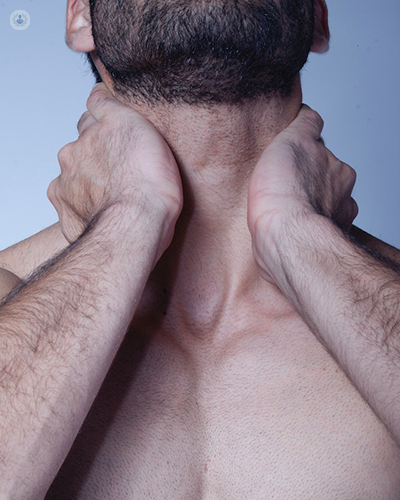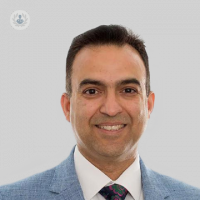Pharyngeal pouch: An expert guide
Written in association with:In this informative article, highly respected consultant ear, nose and throat (ENT) surgeon Mr Gaurav Kumar shares his expert insight on pharyngeal pouch, a condition which can be behind recurrent symptoms of bad breath, chronic cough and frequent chest infections. The revered specialist details the key signs and symptoms to be aware of as well as the diagnostic process and the various approaches to treatment of pharyngeal pouch.

What is a pharyngeal pouch?
As the food we eat passes through the mouth, it follows into the space behind the oral cavity, known as the pharynx, before reaching the food pipe (oesophagus). In some cases, a person’s pharynx may bulge in the lower part, forming a small pocket in which food can sometimes collect. In serious cases, this bulge may become full and sizeable enough that it begins to compress on the oesophagus. This is known as a pharyngeal pouch or Zenker’s diverticulum.
Is a pharyngeal pouch serious?
Pharyngeal pouch is a relatively rare condition which occurs more commonly in men, with symptoms typically showing over the age of seventy. If left untreated, the pouch can become more prominent and can lead to the food regurgitation into the windpipe. This can, in turn, lead to chest infections and in extremely rare cases, cancer of the pharyngeal pouch can develop.
What are the signs and symptoms of a pharyngeal pouch?
The symptoms of a pharyngeal pouch can vary according to its size. When small in size, a pharyngeal pouch can cause a feeling of something being stuck in the throat and can also cause choking on food. If the pouch is left untreated, it can balloon, increasing in size along the food pipe and causing the following symptoms:
- regurgitation of undigested food
- bad breath (halitosis)
- recurrent chest infections
- hoarseness
- chronic cough
- gurgling in the neck
Over time, recurrence of these symptoms may lead to weight loss, bouts of poor health and regular intensive care admissions when treatment for chronic chest infections is required. Symptoms including rapid onset and progressive difficulty in swallowing, pain, blood in vomiting or shortness of breath may be indicative of cancer of the pharyngeal pouch.
How is a pharyngeal pouch diagnosed?
Specialist ENT surgeons provide treatment for pharyngeal pouch. Typically, a detailed history will be taken and an examination will be performed using a small endoscope passed through to nose to visualise the area. Radiological testing, such as a Barium swallow test, may also be performed to give images of the pouch and any other abnormalities in the lower food pipe.
What are the available treatment options?
Many factors are taken into account when deciding on the best form of treatment for pharyngeal pouch, including the patient’s age, general health and suitability to undergo anaesthesia. In addition, the patient’s symptoms, such as mouth opening and neck stiffness as well as the size of the pharyngeal pouch itself are also carefully considered.
Pharyngeal pouch management may be performed through endoscopic or external approaches. Endoscopic management may include pharyngeal pouch stapling, Botox injection or laser surgery to the sphincter while an external approach can be adopted to perform removal of the pouch through the neck or surgical releasing of the upper food pipe sphincter.
Pharyngeal pouch stapling
Pharyngeal pouch stapling, also known as endoscopic staple diverticulostomy, is a minimally invasive procedure performed under general anaesthetic. In this approach, a double lipped unique scope is placed in the patient’s mouth, with one lip in the oesophagus and the other in the pharyngeal pouch. An auto-suture disposable surgical staple is then passed through this endoscope, cutting and sealing the wall between the pouch and the food pipe.
The risk of associated complications such as bleeding, perforation of the food pipe and infection which can spread to the chest is lower in pharyngeal pouch stapling compared to alternative minimally invasive approaches, including laser treatment.
In rare cases, damage to the teeth, wound infection or a recurrence of the pouch can occur with pharyngeal pouch stapling. In addition, in some cases this type of procedure may be unsuccessful if the surgeon is unable to engage the staple due to the small size of the pharyngeal pouch or due to the patient’s neck stiffness.
External approach surgery for pharyngeal pouch
In some cases, a very large pharyngeal pouch, neck stiffness or restricted mouth opening mean a patient is not suitable to undergo procedures using minimally invasive techniques and so an external approach is adopted.
Surgery of this type is performed under general anaesthetic and in most cases, the pharyngeal pouch is exposed and removed through an incision on the left side of the neck. The muscle in the upper part of the oesophagus is released to prevent a recurrence before the incision is closed.
Following surgery, patients typically stay in hospital for seven days and are fed through a tube passed through the nose, with a swallow test being performed before any feeding begins. Complications associated with this procedure include bleeding, wound infection, hoarseness caused by damage to the voice box nerve, chest infections, scarring and recurrence of the pharyngeal pouch.
If you are concerned about the symptoms of pharyngeal pouch and wish to schedule a consultation with Mr Kumar, you can do so by visiting his Top Doctors profile.


